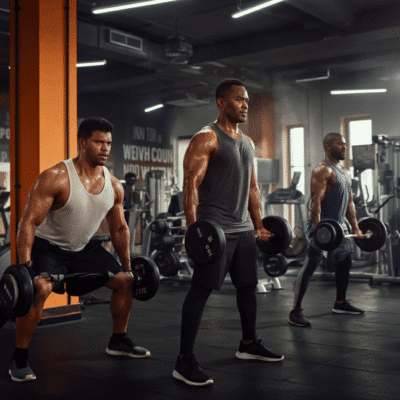A good calisthenics workout plan for beginners can help you reach your fitness goals. You don’t need expensive gym equipment or memberships. Calisthenics uses your body weight to build strength, endurance, and flexibility. It’s a great way to stay fit at home.
By adding a calisthenics workout plan to your daily routine, you can boost your health and fitness. It’s perfect for those who like to work out at home. You only need minimal equipment and a small space. The plan includes exercises like push-ups, squats, and lunges, which can be adjusted for your fitness level.
With a calisthenics workout plan, you can create a home routine that fits your needs and goals. It’s not only easy but also saves money. You won’t need gym memberships or expensive gear. By sticking to a beginner’s calisthenics plan, you can reach your fitness goals and enhance your health and well-being.
Key Takeaways
- Calisthenics is a form of exercise that uses body weight as resistance to build strength, endurance, and flexibility
- A calisthenics workout plan for beginners can be done at home with minimal equipment
- Bodyweight exercises, such as push-ups and squats, are a key part of a calisthenics workout plan
- A home workout routine can be just as effective as a gym-based workout
- A calisthenics workout plan for beginners is a cost-effective and convenient way to get fit at home
- With a well-structured calisthenics workout plan, you can achieve your fitness goals and improve your overall health and well-being
Understanding Calisthenics: The Foundation of Bodyweight Training
Calisthenics training uses your body weight as resistance. It helps build strength, endurance, and flexibility. It’s perfect for beginners because you can do it anywhere without special equipment. It includes various exercises that work different muscle groups, boosting your fitness overall.
Calisthenics training also improves coordination and balance. It challenges your body in many ways, enhancing fitness and athleticism. Plus, you can adjust workouts to fit your fitness level, making it accessible to everyone.
- Improved overall fitness and athleticism
- Increased strength and flexibility
- Enhanced coordination and balance
- Convenient and accessible, as it can be done anywhere
Adding calisthenics training to your routine brings many benefits. It improves your health and well-being. Whether you’re new to fitness or already active, calisthenics is a great way to challenge yourself and reach your goals.
Essential Equipment and Space Requirements
Creating a home workout routine means thinking about what you need. Calisthenics can be done with little gear, but some tools like a pull-up bar or resistance bands can spice up your routine. A good workout plan at home keeps you motivated and on track to your fitness goals.
To start with calisthenics, you’ll need basic calisthenics equipment like a pull-up bar or resistance bands. Adding a jump rope or medicine ball can also mix up your exercises. Here’s what you should consider:
- Pull-up bar: This is a must-have for any calisthenics workout routine.
- Resistance bands: These are great for adding variety to your workouts and can be used for a range of exercises.
- Jump rope: This is a great cardio exercise that can be done at home.
- Medicine ball: This is a great tool for adding strength training to your workouts.
You’ll also need a dedicated workout space at home. This could be a spare room, garage, or backyard. The goal is to have a space that encourages exercise and keeps you motivated. With the right gear and space, you can make a powerful home workout routine that reaches your fitness goals.
Basic Calisthenics Movements for Beginners
Starting a calisthenics exercises routine is exciting. It’s key to begin with simple movements that work different muscles. As a beginner, adding bodyweight exercises for beginners to your home workout routine is a great way to build strength and endurance. Let’s look at the basic movements to kickstart your calisthenics journey.
For a balanced home workout routine, focus on exercises for your upper, lower body, and core. This ensures you’re working all major muscle groups. By doing these exercises daily, you’ll boost your fitness and overall health.
- Push-ups: great for building upper body strength
- Squats: excellent for working your lower body
- Planks: perfect for engaging your core and improving overall stability
Mastering these basiccalisthenics exercises and adding them to yourhome workout routine will help you reach your fitness goals. You’ll also build a strong base for more challenging movements.
Proper Form and Technique Guidelines
When doing calisthenics exercises, it’s key to focus on the right form and technique. This helps avoid injuries and makes workouts more effective. Bodyweight exercises work many muscles at once. Wrong form can cause strain or harm.
To get good at calisthenics exercises, watch your posture, alignment, and breathing. These are crucial.
Understanding each exercise’s movement pattern is important. For instance, in a push-up, keep your core tight, shoulders down, and lower until your chest almost touches the ground. In a squat, keep your back straight, core engaged, and lower until your thighs are almost parallel to the ground.
- Start slow and control your movements
- Keep your alignment and posture right
- Use your core and stay stable
- Breathe naturally and don’t hold your breath
By following these tips and practicing proper form, you can do calisthenics exercises safely and effectively. This will help you reach your fitness goals and boost your overall health.
Complete Calisthenics Workout Plan for Beginners
A good calisthenics workout plan is key for beginners to reach their fitness goals. When making a workout plan at home, think about your current fitness level. Start with simple exercises and slowly add more challenging ones. This way, you’ll build strength, endurance, and flexibility.
Understanding progressive overload is crucial in your calisthenics workout plan. It means you should gradually increase the difficulty of your exercises. A 4-week workout plan at home for beginners might look like this:
- Week one: Start with basic exercises like push-ups, squats, and lunges to lay a solid foundation.
- Week two: Add more repetitions or sets to your routine to increase intensity.
- Week three: Try new exercises that work different muscle groups, such as planks, dips, and leg raises.
- Week four: Move on to more challenging exercises and boost the overall intensity of your calisthenics workout plan.
Always listen to your body and rest when you need to. Combining your workout plan at home with a healthy diet and lifestyle is also vital. With hard work and consistency, you can meet your fitness for beginners goals and build a strong foundation for a healthy life.
Recovery and Rest Day Strategies
When you do calisthenics training, it’s key to let your body rest and recover. This is very important for fitness for beginners. Their bodies are still getting used to exercise. Resting helps your muscles get stronger and reduces injury risk.
A good calisthenics workout plan includes rest days. These can be active or passive. Active recovery, like light cardio or stretching, helps with blood flow and soreness. Passive recovery means just resting, letting your body fully recharge.
- Getting enough sleep to aid in muscle repair and growth
- Staying hydrated to help flush out toxins and support muscle function
- Eating a balanced diet that includes plenty of protein, complex carbohydrates, and healthy fats
By using these strategies, you can make your recovery and rest days better. This leads to better results and less injury risk. Remember, fitness for beginners needs patience and consistency. Always listen to your body and give it time to recover and adapt.
Common Mistakes to Avoid
Starting a calisthenics program? Be careful of common mistakes that can slow you down and hurt you. One big mistake is bad form and technique in bodyweight exercises. This can make your workouts less effective and harm your muscles and joints.
Another mistake is overtraining. It can make you tired, lose motivation, and increase injury risk. It’s key to mix training with rest days to let your body heal and grow. Skipping rest days can cause burnout and slow your progress.
Here are some common mistakes to watch out for in calisthenics training:
- Insufficient warm-up and cool-down routines
- Incorrect posture and alignment during exercises
- Overreliance on a single type of exercise or routine
- Failure to progress exercises as fitness levels improve
To avoid these mistakes, focus on proper form and technique, listen to your body, and adjust as needed. This way, you can enjoy a safe and effective calisthenics workout. It will help you stay fit and healthy.
Tracking Progress and Setting Goals
Starting your calisthenics workout plan? It’s key to track your progress and set goals. This keeps you motivated and focused on your fitness goals. By watching your progress, you can see what needs work and tweak your plan.
There are important metrics to track in your progress. These include:
- Workout frequency and consistency
- Exercise completion and technique
- Set and rep counts
- Rest and recovery time
Tracking these helps you set realistic goals and a timeline for your fitness journey. A good calisthenics plan should regularly check your progress and adjust as needed.
Setting goals is also vital for success in calisthenics. Specific, measurable, and achievable goals guide your fitness path. They keep you motivated to reach your fitness targets, whether it’s strength, flexibility, or overall fitness.
Remember, tracking progress and setting goals is a continuous effort. As you move forward in your calisthenics plan, regularly check and adjust your goals. This ensures you keep challenging yourself and meet your fitness goals.
Scaling and Modifying Exercises
As you get better at calisthenics, it’s key to know how to adjust exercises. You can make workouts harder or easier based on your fitness level and goals. This means doing fewer reps or sets, or adding weight to your exercises.
If an exercise is too hard, try doing fewer reps or sets. If it’s too easy, add weight or resistance. This keeps you challenged and helps you progress in your workouts.
Here are some ways to adjust your exercises:
- Reduce the number of reps or sets
- Add weight or resistance to make it harder
- Change the angle or position of your body
- Use different equipment, like resistance bands or a pull-up bar
Learning to adjust exercises helps you tailor your workout to your needs. It keeps you motivated and ensures you see results from your efforts.
Building a Sustainable Routine
Starting a calisthenics workout plan is just the beginning for fitness for beginners. To keep going, you need to build a routine that includes regular exercise, healthy food, and enough sleep. A good routine helps you stay disciplined and on track with your workouts.
Creating a schedule that fits your life is key to building a routine. Plan out times for exercise, eating well, and relaxing. This way, you can make steady progress towards your fitness goals. For instance, start with 30 minutes of calisthenics workout each day, then eat a healthy meal and relax.
Here are some tips to help you build a routine and stay on track with your calisthenics workout plan:
- Start small and gradually increase the intensity and duration of your workouts
- Find a workout buddy or join a fitness community to stay motivated
- Track your progress and set realistic milestones
- Listen to your body and take rest days when needed
By using these tips and adding them to your daily routine, you can set yourself up for success. Remember, building a routine takes time and effort. But the benefits are worth it.
Conclusion: Your Journey to Calisthenics Mastery
As you finish this calisthenics workout plan for beginners, think about how far you’ve come. Your path to calisthenics mastery is just starting, but you’ve laid a strong foundation.
Consistency is crucial. Keep up with the workouts, focus on form, and slowly add more challenging exercises. With hard work and patience, you’ll see big improvements in strength, flexibility, and fitness.
But it’s not just about the body. Calisthenics also boosts your mental health. Feeling proud and strong from mastering bodyweight exercises is incredibly fulfilling.
Face the challenges, celebrate your wins, and keep reaching for new heights. This calisthenics workout plan at home is your ticket to a healthier, more confident you. Your fitness for beginners adventure is just starting.
FAQ
What is calisthenics?
Calisthenics is a workout that uses your body weight to build strength and flexibility. It includes exercises like push-ups, squats, and pull-ups. You don’t need any equipment for these.
What are the benefits of calisthenics training?
Calisthenics improves your fitness, strength, and flexibility. It also boosts your coordination and balance. Plus, you can work out anywhere without expensive gym gear or memberships.
Why should I choose calisthenics over gym workouts?
Calisthenics is great for beginners. It helps you build a strong foundation of bodyweight exercises. You can do them anywhere, without the need for expensive gym memberships or equipment.
What essential equipment and space do I need for a calisthenics workout at home?
For calisthenics, you might want a pull-up bar, resistance bands, or a jump rope. Having a dedicated workout space at home also helps. It makes exercising more motivating.
What are some basic calisthenics movements for beginners?
Beginners should start with upper body exercises like push-ups and pull-ups. Lower body exercises include squats and lunges. Don’t forget core strengthening movements like planks and Russian twists.
How important is proper form and technique in calisthenics?
Proper form and technique are key in calisthenics. They prevent injuries and ensure effective workouts. Beginners should learn the correct posture, alignment, and breathing for each exercise.
What does a complete calisthenics workout plan for beginners look like?
A beginner’s calisthenics plan includes a 4-week schedule with progressive overload. Each week adds more to your strength, endurance, and flexibility. It mixes upper body, lower body, and core exercises.
Why are recovery and rest days important in a calisthenics workout plan?
Rest days let your body recover and rebuild muscle. Active recovery, like stretching and light cardio, helps too. Proper sleep and nutrition also support your training.
What common mistakes should I avoid when doing calisthenics?
Avoid poor form, overtraining, and skipping rest days. Being aware of these mistakes helps you stay safe and effective in your workouts.
How can I track my progress and set goals in a calisthenics workout plan?
Tracking your progress and setting goals keeps you motivated. Measure your improvements and set achievable goals. A timeline helps you reach your fitness goals.
How can I scale and modify calisthenics exercises to suit my fitness level?
You can adjust exercises to fit your fitness level. Make them easier or harder by changing the number of reps or adding weight.
How can I build a sustainable calisthenics routine?
Create a weekly schedule and stay motivated. Use strategies for long-term success. Overcome obstacles and make your workouts a lasting part of your life.









